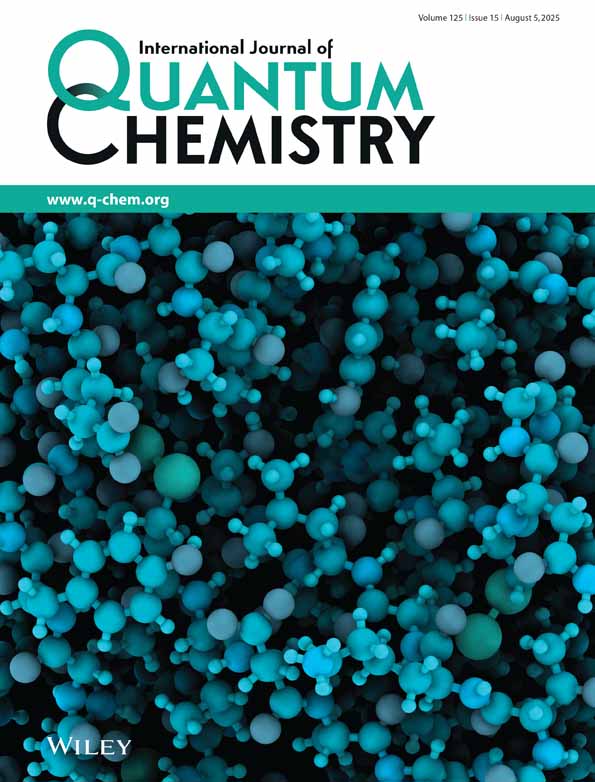New implementation of the graphical unitary group approach for multireference direct configuration interaction calculations
Corresponding Author
Hans Lischka
Department of Chemistry, Ohio State University, Columbus, Ohio 43210
Work carried out during the tenure of a fellowship award from the Max Kade Foundation, Inc.
Institut für Theoretische Chemie und Strahlenchemie, Universität Wien, Währingerstrasse 17, A-1090 Wien, AustriaSearch for more papers by this authorRon Shepard
Battelle, Columbus Laboratories, Columbus, Ohio 43201
Search for more papers by this authorFranklin B. Brown
Department of Chemistry, Ohio State University, Columbus, Ohio 43210
Eastman Kodak predoctoral fellow.
Search for more papers by this authorIsaiah Shavitt
Battelle, Columbus Laboratories, Columbus, Ohio 43201 and Department of Chemistry, Ohio State University, Columbus, Ohio 43210
Search for more papers by this authorCorresponding Author
Hans Lischka
Department of Chemistry, Ohio State University, Columbus, Ohio 43210
Work carried out during the tenure of a fellowship award from the Max Kade Foundation, Inc.
Institut für Theoretische Chemie und Strahlenchemie, Universität Wien, Währingerstrasse 17, A-1090 Wien, AustriaSearch for more papers by this authorRon Shepard
Battelle, Columbus Laboratories, Columbus, Ohio 43201
Search for more papers by this authorFranklin B. Brown
Department of Chemistry, Ohio State University, Columbus, Ohio 43210
Eastman Kodak predoctoral fellow.
Search for more papers by this authorIsaiah Shavitt
Battelle, Columbus Laboratories, Columbus, Ohio 43201 and Department of Chemistry, Ohio State University, Columbus, Ohio 43210
Search for more papers by this authorAbstract
Improved procedures were used in a new computer implementation of the graphical unitary group approach, designed specifically for efficient multireference configuration interaction calculations for molecules. These procedures include improvements in the treatment of spatial symmetry and of the multireference interacting space, and include the “repartitioned Hamiltonian,” which provides a flexible alternative to conventional particle-hole formalisms. The new computer programs avoid the construction of very long formula files, and leave the matrix eigenvector iterations as the only significant rate-determining step in large-scale direct CI calculations.
Bibliography
- 1 J. Hinze, Ed., The Unitary Group for the Evaluation of Electronic Energy Matrix Elements, Lecture Notes in Chemistry, Vol. 22 (Springer-Verlag, Berlin, 1981).
- 2
J. Paldus,
in The Unitary Group for the Evaluation of Electronic Energy Matrix Elements,
J. Hinze, Ed.
(Springer-Verlag, Berlin,
1981),
p. 1.
10.1007/978-3-642-93163-5_1 Google Scholar
- 3
I. Shavitt,
in The Unitary Group for the Evaluation of Electronic Energy Matrix Elements,
J. Hinze, Ed.
(Springer-Verlag, Berlin,
1981)
p. 51.
10.1007/978-3-642-93163-5_2 Google Scholar
- 4
B. O. Roos,
Chem. Phys. Lett.
15,
153
(1972);
B. O. Roos and
P. E. M. Siegbahn,
in Methods of Electronic Structure Theory,
H. F. Schaefer, Ed.
(Plenum, New York,
1977),
p. 277.
10.1007/978-1-4757-0887-5_7 Google Scholar
- 5
R. F. Hausman, Jr.,
S. D. Bloom, and
C. F. Bender,
Chem. Phys. Lett.
32,
483
(1975);
R. F. Hausman, Jr. and
C. F. Bender,
in Methods of Electronic Structure Theory,
H. F. Schaefer, Ed.
(Plenum, New York,
1977),
p. 319.
10.1007/978-1-4757-0887-5_8 Google Scholar
- 6 B. R. Brooks and H. F. Schaefer III, J. Chem. Phys. 70, 5092 (1979).
- 7 B. R. Brooks, W. D. Laidig, P. Saxe, N. C. Handy, and H. F. Schaefer, III, Phys. Scripta 21, 312 (1980).
- 8
B. R. Brooks,
W. D. Laidig,
P. Saxe,
J. Goddard, and
H. F. Schaefer, III,
The Unitary Group for the Evaluation of Electronic Energy Matrix Elements,
J. Hinze, Ed.
(Springer-Verlag, Berin,
1981),
p. 158.
10.1007/978-3-642-93163-5_8 Google Scholar
- 9 P. E. M. Siegbahn, J. Chem. Phys. 70, 5391 (1979).
- 10 P. E. M. Siegbahn, J. Chem. Phys. 72, 1647 (1980).
- 11
P. E. M. Siegbahn,
in The Unitary Group for the Evaluation of Electronic Energy Matrix Elements,
J. Hinze, Ed.
(Springer-Verlag, Berlin,
1981),
p. 119.
10.1007/978-3-642-93163-5_5 Google Scholar
- 12 A. Bunge, J. Chem. Phys. 53, 20 (1970).
- 13 A. D. McLean and B. Liu, J. Chem. Phys. 58, 1066 (1973).
- 14 J. Paldus, in Electron Correlation: Proceedings of the Daresbury Study Weekend, 17–18 November, 1979, M. F. Guest and S. Wilson, Eds. (Science Research Council, Daresbury Laboratory, Warrington, England, 1980), p. 40.
- 15 J. Paldus and M. J. Boyle, Phys. Rev. A 22, 2299 (1980).
- 16 M. J. Boyle and J. Paldus, Phys. Rev. A 22, 2316 (1980).
- 17 I. Shavitt, Chem. Phys. Lett. 63, 421 (1979).
- 18 I. Shavitt, “ New Methods in Computational Quantum Chemistry and Their Application on Modern Super-Computers” (Annual Report to the National Aeronautics and Space Administration), Battelle Columbus Laboratories, June 1979.
- 19 E. R. Davidson, J. Comput. Phys. 17, 87 (1975).
- 20 I. Shavitt, Int. J. Quantum Chem. Quantum Chem. Symp. 12, 5 (1978).
- 21 R. M. Pitzer and H. F. Schaefer III, Molecular Integrals Program 194720 (private communication).
- 22 H.-L. Hsu, E. R. Davidson, and R. M. Pitzer, J. Chem. Phys. 65, 609 (1976); SCF Program S43210 (private communication).
- 23 M. Dupuis, J. Rys, and H. F. King, J. Chem. Phys. 65, 111 (1976).
- 24 R. M. Pitzer, J. Chem. Phys. 58, 3111 (1973).
- 25 R. Shepard and J. Simons, Int. J. Quantum Chem. Quantum Chem. Symp. 14, 211 (1980).
- 26 C. F. Bender, J. Comput. Phys. 9, 547 (1972).
- 27 N. C. Handy, in Electron Correlation: Proceedings of the Daresbury Study Weekend, 17–18 November, 1979, M. F. Guest and S. Wilson, Eds. (Science Research Council, Daresbury Laboratory, Warrington, England, 1980), p. 78.
- 28
I. Shavitt,
in Methods of Electronic Structure Theory,
H. F. Schaefer, Ed.
(Plenum, New York,
1977),
p. 189.
10.1007/978-1-4757-0887-5_6 Google Scholar
- 29 R. J. Buenker, S. D. Peyerimhoff, and W. Butscher, Mol. Phys. 35, 771 (1978).




